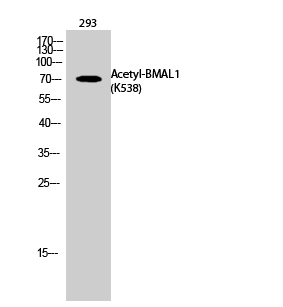产品名称
BMAL1 (Acetyl Lys538) Rabbit Polyclonal Antibody
别名
ARNTL; BHLHE5; BMAL1; MOP3; PASD3; Aryl hydrocarbon receptor nuclear translocator-like protein 1; Basic-helix-loop-helix-PAS protein MOP3Brain and muscle ARNT-like 1; Class E basic helix-loop-helix protein 5; bHLHe5; Member of PAS protein 3; PAS domain-containing protein 3; bHLH-PAS protein JAP3
蛋白名称
Aryl hydrocarbon receptor nuclear translocator-like protein 1
存储缓冲液
Liquid in PBS containing 50% glycerol, 0.5% BSA and 0.02% New type preservative N.
Human Gene Link
http://www.ncbi.nlm.nih.gov/sites/entrez?db=gene&term=406
Human Swissprot No.
O00327
Human Swissprot Link
http://www.uniprot.org/uniprotkb/O00327/entry
Mouse Gene Link
http://www.ncbi.nlm.nih.gov/sites/entrez?db=gene&term=11865
Mouse Swissprot No.
Q9WTL8
Mouse Swissprot Link
http://www.uniprot.org/uniprot/Q9WTL8
Rat Gene Link
http://www.ncbi.nlm.nih.gov/sites/entrez?db=gene&term=29657
Rat Swissprot Link
http://www.uniprot.org/uniprot/Q9EPW1
免疫原
The antiserum was produced against synthesized Acetyl-peptide derived from human BMAL1 around the Acetylation site of Lys538. AA range:501-550
特异性
Acetyl-BMAL1 (K538) Polyclonal Antibody detects endogenous levels of BMAL1 protein only when acetylated at K538.
稀释度
WB 1:500 - 1:2000. ELISA: 1:20000. Not yet tested in other applications.
宿主
Polyclonal, Rabbit,IgG
背景介绍
The protein encoded by this gene is a basic helix-loop-helix protein that forms a heterodimer with CLOCK. This heterodimer binds E-box enhancer elements upstream of Period (PER1, PER2, PER3) and Cryptochrome (CRY1, CRY2) genes and activates transcription of these genes. PER and CRY proteins heterodimerize and repress their own transcription by interacting in a feedback loop with CLOCK/ARNTL complexes. Defects in this gene have been linked to infertility, problems with gluconeogenesis and lipogenesis, and altered sleep patterns. Several transcript variants encoding different isoforms have been found for this gene. [provided by RefSeq, Jul 2014],
组织表达
Hair follicles (at protein level). Highly expressed in the adult brain, skeletal muscle and heart.
细胞定位
Nucleus . Cytoplasm . Nucleus, PML body . Shuttles between the nucleus and the cytoplasm and this nucleocytoplasmic shuttling is essential for the nuclear accumulation of CLOCK, target gene transcription and the degradation of the CLOCK-ARNTL/BMAL1 heterodimer. The sumoylated form localizes in the PML body. Sequestered to the cytoplasm in the presence of ID2. .
功能
alternative products:Additional isoforms seem to exist,function:ARNTL-CLOCK heterodimers activate E-box element (3'-CACGTG-5') transcription of a number of proteins of the circadian clock. This transcription is inhibited in a feedback loop by PER, and also by CRY proteins.,miscellaneous:CLOCK-ARNTL double mutations within the PAS domains result in syngernistic desensitization to high levels of CRY on repression of CLOCK-ARNTL transcriptional activity of PER1 and, disrupt circadian rhythmicity.,PTM:Acetylated on Lys-538 upon dimerization with CLOCK. Acetylation facilitates CRY1-mediated repression.,PTM:Phosphorylated upon dimerization with CLOCK.,PTM:Sumoylated on Lys-259 upon dimerization with CLOCK.,similarity:Contains 1 basic helix-loop-helix (bHLH) domain.,similarity:Contains 1 PAC (PAS-associated C-terminal) domain.,similarity:Contains 2 PAS (PER-ARNT-SIM) domains.,subunit:Component of the circadian clock oscillator which includes the CRY proteins, CLOCK or NPAS2, ARNTL or ARNTL2, CSNK1D and/or CSNK1E, TIMELESS and the PER proteins. Efficient DNA binding requires dimerization with another bHLH protein. Heterodimerization with CLOCK is required for E-box-dependent transactivation, for CLOCK nuclear translocation and degradation, and, for phosphorylation of both CLOCK and ARNTL. Interaction with PER and CRY proteins requires translocation to the nucleus. Interaction of the CLOCK-ARNTL heterodimer with PER or CRY inhibits transcription activation. Interacts with HSP90; with AHR in vitro, but not in vivo.,tissue specificity:Highly expressed in the adult brain, skeletal muscle and heart.,
纯化
The antibody was affinity-purified from rabbit antiserum by affinity-chromatography using epitope-specific immunogen.


